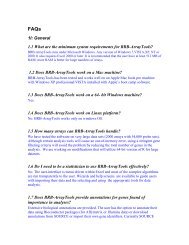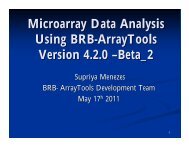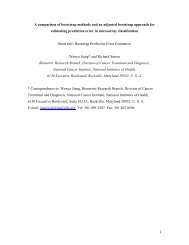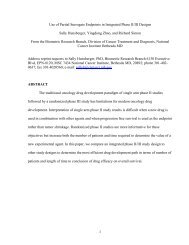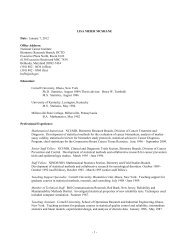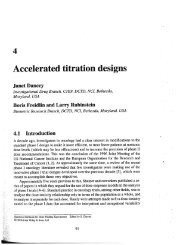Identification of Pharmacogenomic Biomarker Classifiers in Cancer ...
Identification of Pharmacogenomic Biomarker Classifiers in Cancer ...
Identification of Pharmacogenomic Biomarker Classifiers in Cancer ...
You also want an ePaper? Increase the reach of your titles
YUMPU automatically turns print PDFs into web optimized ePapers that Google loves.
likely to be responsive to the new treatment. If the null hypothesis is rejected, then the<br />
treatment is considered effective for the classifier determ<strong>in</strong>ed subset. This analysis<br />
strategy provides sponsors an <strong>in</strong>centive for develop<strong>in</strong>g genomic classifiers for target<strong>in</strong>g<br />
therapy <strong>in</strong> a manner that does not unduly deprive them <strong>of</strong> the possibility <strong>of</strong> broad label<strong>in</strong>g<br />
<strong>in</strong>dications when justified by the data.<br />
8. Conclusions<br />
Physicians need improved tools for select<strong>in</strong>g treatments for <strong>in</strong>dividual patients. The<br />
genomic technologies available today are sufficient to develop such tools. There is not<br />
broad understand<strong>in</strong>g <strong>of</strong> the steps needed to translate research f<strong>in</strong>d<strong>in</strong>gs <strong>of</strong> correlations<br />
between gene expression and prognosis <strong>in</strong>to robust diagnostics validated to be <strong>of</strong> cl<strong>in</strong>ical<br />
utility. This paper has attempted to identify some <strong>of</strong> the major steps needed for such<br />
translation.<br />
Acknowledgements<br />
Thanks to Dr. Wenyu Jiang for the comput<strong>in</strong>g <strong>of</strong> Tables 1 and 2.<br />
18



